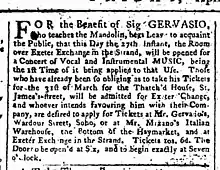Giovanni Battista Gervasio
Giovanni Battista Gervasio (c. 1725 - c. 1785) was an Italian musician and composer. Born in Naples he was one of the first generation of virtuoso-mandolinists who left Italy and played the mandolin in Europe in the 18th century.[1][2] He was a composer for the mandolin and his works can be found scattered in 18th century collections such as the Gimo music collection and the Bibliothèque Nationale de France.[3][4] He also wrote a mandolin method Methode facile pour apprendre a quatre cordes, instrument pour les dames (Easy method for learning four-string instruments for ladies), published in Paris in 1767.[5] He performed in London 1768 and in Frankfurt-on-the-Main in December 10, 1777 and the Concert Spirituel in Paris on December 24, 1784 .[1][5] He advertised in 1785 that he was master of singing and mandolin to Her Royal Highess, the Princess of Prussia.[5] A work of music addressed to her exists today in the Bibliothèque Nationale de France.[3]

Gervasio advertised his teaching services in Grenoble in 1785.[5] As the last known advertisement for him, it has been proposed that he settled and later died there.[5]
Works
Gimo collection
Works in the Gimo collection were collected by a Swedish man, Jean Lefebure, "in the first half of 1762" in Italy.[4] They were hand-copied commercial products.[4]
- Mandolin Sonata in C major (Sonata Per Camera di Mandolino e Basso), mandolin and bass (Gimo 141)[4][6]
- Mandolin Sonata in D major (Sonata Per Camera di Mandolino e Basso ), mandolin and bass (Gimo 142)(Gimo 143)[4][6]
- Mandolin Sonata in D major (Sonata Per Camera di Mandolino e Basso), mandolin and bass (Gimo 144)[4][6]
- Mandolin Sonata in G major (Sonata per Mandolino e Basso), mandolin and bass (Gimo 145)(Gimo 146)[4][6]
- Duet in E-flat major for Two Mandolins (Duetto à Due Mandolini) (Gimo 147)[4][6]
- Trio Sonata in D Major (Trio Sonata per Camera di Mandolino è Basso) (Gimo 149)[4][7]
- Trio in D major (Trio a Due Mandolini e Basso), 2 mandolins and bass (Gimo 150)[4][6]
Other collections
- Sonata for Mandolin, bass. No. 1. D major, (kept Bibliothèque Nationale de France)[3] This is in two parts; possibly the same work that Konrad Wölki called Two sonatas four mandolin and bass and said was "held in Paris."[1]
- Six duets for two mandolins[1]
- Airs for the mandolin, guitar, violin or German flute interspersed with songs[1]
- two sonatas for mandolin and bass[1]
Gallery
The Sonata for mandolin, bass. No. 1. D major by Giovai Battista Gervasio (from Naples), given to a Prussian princess. The work was labeled "for fun and chamber study" on the title page.
Recordings
References
- Sparks, Paul (2003). The Classical Mandolin. Oxford: Oxford University Press. ISBN 9780195173376.
- Wölki, Konrad (1984). Geschichte der Mandoline [History of the Mandolin]. Translated by Harris, Keith. Arlington, Virginia: Plucked String. p. 10.
- Sparks 2003, p. 218
- "PartitionSonata per // Mandolino e Basso // Composta per Divertimento e Studio ... Gervasio, Giovanni Battista (1725-1785". gallica.bnf.fr. Retrieved 2 May 2019.
- Sandberg, Erik. "The Gimo Music Collection". mutopiaproject.org. Retrieved 2 May 2018.
- joachim (19 August 2006). "Giovanni Battista GERVASIO (1725-1785)". musiqueclassique.forumpro.fr. Retrieved 2 May 2019.
- "Giovanni Battista Gervasio (ca.1725 — ca.1785)". imslp.org. Retrieved 2 May 2019.
- "Trio Sonata in D major (Gervasio, Giovanni Battista)". imslp.org. Retrieved 2 May 2019.
- "Il mandolino italiano nel settecento". Retrieved 14 June 2019.
[Last three tracks on album:] Sonata in Re maggiore, allegro. Sonata in Re maggiore, largo amoroso. Sonata in Re maggiore, taice alla tedesca
- "Gimo-Samling: 18th Century Sonatas & Trio Sonatas for Mandolin". Retrieved 14 June 2019.
[Tracks 4-6 and 10-18 are by Gervasio:] (4-6) Sinfonia for 2 Mandolins & Continuo, Gimo 149, (10-12) Sonata for Mandolin & Continuo, Gimo 141, (13-15) Trio for 2 Mandolins & Continuo, Gimo 150, (16-18) Sonata per camera, Gimo 143.
Gervasio_Giovanni_btv1b10540698v.jpg.webp)
Gervasio_Giovanni_btv1b10540698v.jpg.webp)
Gervasio_Giovanni_btv1b10540698v.jpg.webp)
Gervasio_Giovanni_btv1b10540698v.jpg.webp)
Gervasio_Giovanni_btv1b10540698v.jpg.webp)
Gervasio_Giovanni_btv1b10540698v.jpg.webp)
Gervasio_Giovanni_btv1b10540698v.jpg.webp)